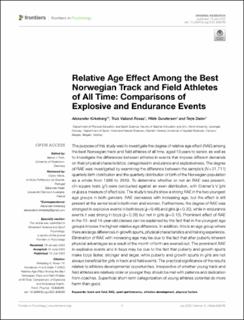| dc.contributor.author | Kirkeberg, Alexander | |
| dc.contributor.author | Roaas, Truls Valland | |
| dc.contributor.author | Gundersen, Hilde | |
| dc.contributor.author | Dalen, Terje | |
| dc.date.accessioned | 2022-11-10T10:39:14Z | |
| dc.date.available | 2022-11-10T10:39:14Z | |
| dc.date.created | 2022-07-29T11:38:06Z | |
| dc.date.issued | 2022 | |
| dc.identifier.citation | Kirkeberg, A., Roaas, T. V., Gundersen, H., & Dalen, T. (2022). Relative Age Effect Among the Best Norwegian Track and Field Athletes of All Time: Comparisons of Explosive and Endurance Events. Frontiers in Psychology, 13:858095. | en_US |
| dc.identifier.issn | 1664-1078 | |
| dc.identifier.uri | https://hdl.handle.net/11250/3031119 | |
| dc.description.abstract | The purpose of this study was to investigate the degree of relative age effect (RAE) among the best Norwegian track and field athletes of all time, aged 13 years to senior, as well as to investigate the differences between athletes in events that impose different demands on their physical characteristics, categorised in endurance and explosiveness. The degree of RAE was investigated by examining the difference between the sample’s (N = 21,711) quarterly birth distribution and the quarterly distribution of birth of the Norwegian population as a whole from 1966 to 2019. To determine whether or not an RAE was present, chi-square tests (χ2) were conducted against an even distribution, with Cramer’s V (phi or ɸ) as a measure of effect size. The study’s results show a strong RAE in the two youngest age groups in both genders. RAE decreases with increasing age, but the effect is still present at the senior level in both men and women. Furthermore, the degree of RAE was strongest in explosive events in both boys (ɸ = 0.46) and girls (ɸ = 0.30), while in endurance events it was strong in boys (ɸ = 0.38) but not in girls (ɸ = 0.13). Prominent effect of RAE in the 13- and 14-year-old classes can be explained by the fact that in the youngest age groups impose the highest relative age difference. In addition, this is an age group where there are large differences in growth spurts, physical characteristics and training experience. Elimination of RAE with increasing age may be due to the fact that after puberty inherent physical advantages as a result of the month of birth are evened out. The prominent RAE in explosive events and in boys may be due to the fact that puberty and growth spurts make boys faster, stronger and larger, while puberty and growth spurts in girls are not always beneficial for girls in track and field events. The practical significance of the results relates to athletes developmental opportunities. Irrespective of whether young track and field athletes are relatively older or younger they should be met with patience and dedication from coaches. Superficial short-term categorization of young athletes potential do more harm than good. | en_US |
| dc.language.iso | eng | en_US |
| dc.publisher | Frontiers Media | en_US |
| dc.rights | Navngivelse 4.0 Internasjonal | * |
| dc.rights.uri | http://creativecommons.org/licenses/by/4.0/deed.no | * |
| dc.title | Relative Age Effect Among the Best Norwegian Track and Field Athletes of All Time: Comparisons of Explosive and Endurance Events | en_US |
| dc.type | Peer reviewed | en_US |
| dc.type | Journal article | en_US |
| dc.description.version | publishedVersion | en_US |
| dc.rights.holder | © 2022 Kirkeberg, Roaas, Gundersen and Dalen. | en_US |
| dc.source.pagenumber | 10 | en_US |
| dc.source.volume | 13 | en_US |
| dc.source.journal | Frontiers in Psychology | en_US |
| dc.identifier.doi | 10.3389/fpsyg.2022.858095 | |
| dc.identifier.cristin | 2040048 | |
| dc.source.articlenumber | 858095 | en_US |
| cristin.ispublished | true | |
| cristin.fulltext | original | |
| cristin.qualitycode | 1 | |

